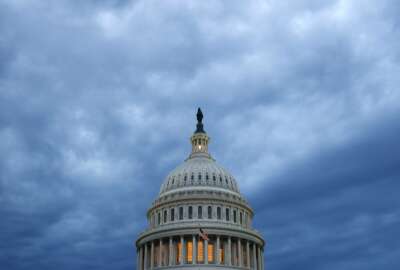Hubbard Radio Washington DC, LLC. All rights reserved. This website is not intended for users located within the European Economic Area.
House tech leadership biggest surprise of summer changes
Alan Thompson, the CIO, and Justin Black, the CTO, of the House of Representatives were among the federal IT executives leaving their positions over the summer.
The summer isn’t officially over, and with a heat wave stretching from the Plains through the Midwest and into the East Coast this week, it may continue to feel like the dog days of summer for quite a while. But we can pretend fall is just around the corner what with the college football season kicking off last weekend, the NFL starting this week. And now that we are past Labor Day, it’s time to look back at some of the major people changes in the federal IT community over the summer.
One of the most surprising changes came not in the executive branch, but on Capitol Hill.
Multiple sources confirmed, and reacted with both surprise and bewilderment, the House of Representatives decided to part ways with both their chief information officer AND chief technology officer in late May or early June, depending on who you talk to.
Alan Thompson, the CIO, and Justin Black, the CTO, were relieved of their duties because the chief administrative officer, or maybe House leadership, “wanted to go in a new direction,” multiple sources say.

A spokeswoman for the House CAO declined comment on the personnel changes.
Attempts to reach Thompson and Black via LinkedIn were unsuccessful.
Sources also have confirmed that Jamie Crotts is the acting CIO of the House of Representatives. He previously served as the chief information security officer of the House for about eight months and has been director of cybersecurity awareness and policy for six years previously.
Crotts came to the House after spending about 13 years in the private sector with Booz Allen Hamilton and Deloitte.
It’s unclear if Thompson and Black were fired or just asked to leave or left on their own will. No matter the specific circumstances, sources said the decision is surprising nonetheless given both of their impacts on the House to bring the technology members use into the modern era.
Thompson came to the CAO’s office in May 2020 from the Carlyle Group, first as deputy CIO, and then rose to acting and finally permanent CIO a year later.
Black had been CTO since 2018, coming to the CAO after spending 10 years with the Department of Veterans Affairs inspector general’s office where he led the data analytics effort and was the CIO for eight years.
Thompson said back in June 2022 in an interview that one of his top priorities was to make it easier for lawmakers’ office to adopt digital services. He said by filling the gaps in knowledge and skillsets, the CAO’s new office of digital services could accelerate the modernization of Congress.
As part of this digital services effort, Thompson and Black worked on improving the technology infrastructure for the House over the last few years. This includes bringing better Wi-Fi access in the office buildings, a pilot in the district offices to improve their wireless connectivity with the goal of making it easier to connect offices and people.
In the CAO’s semiannual report to Congress released in June, the digital services team continued to make progress in launching new tools, including “the team’s very first home-grown product: Deconflict. Intended primarily for use in committee offices, this modern calendar interface provides staff visibility into each House committee’s upcoming hearings and markups before they are publicly noticed.”
Executives retire from GSA
Thompson and Black weren’t the only notable names leaving federal services over the last few months.
Carol Ochoa, the inspector general of the General Services Administration, retired after 37 years in government. She had been GSA’s IG since 2015 and joined the government in 1989 as an assistant U.S. attorney in Washington, D.C.
Robert Erickson is the current acting IG until President Joe Biden names a permanent one.
Ochoa’s tenure at GSA continued the tenuous relationship between the IG’s office and the administrator’s office.

Some said Ochoa and her staff were overly critical or aggressive around certain and specific areas, particularly during the Trump administration.
One ongoing area of disagreement that neither the IG’s office and the Federal Acquisition Service can find common ground on is the continued use of the Transactional Data Reporting (TDR) framework for tracking prices on the schedules program.
One of Ochoa’s final investigations showed major problems with the Login.gov program.
“During her roughly eight years of service as GSA IG, she led audit and inspection efforts which produced nearly 600 reports to GSA, and ultimately to Congress. The reports provided recommendations for corrective actions to address serious deficiencies found in GSA programs,” said Rep. Gerry Connolly (D-Va.), in a statement on the House floor recognizing Ochoa’s service. “These reports also included extremely valuable contract audits which, over her term, identified more than $4 billion in potential savings in the form of questioned costs or funds that could be put to better use.”
In addition to Ochoa, Larry Lee Gregg, the assistant IG at GSA, also retired after 50 years of federal service.
Also leaving GSA is Zach Baldwin, the automation lead for the Federal Risk Authorization Management Program (FedRAMP), after 20 years of federal service.
“It’s really hard to walk away after such a long time — the hardest thing is leaving projects I felt passionately about undone and walking away from some long term relationships I’ve developed,” Baldwin wrote on LinkedIn. “I am very proud of some of the projects that I have been involved in over the years. I was part of bringing cloud to the federal government by creating the first cloud blanket purchase agreement (BPA). I supported and helped lead the Federal Data Center Consolidation which helped the entire government migrate from legacy physical data centers to the cloud. I was there at the creation of FedRAMP, but only significantly contributed when I returned to the program and lead the automation initiatives. I’m excited to see the future of automation as the foundations I helped set are actualized into what I am sure is the future of FedRAMP and cybersecurity. It’s been a great career. I hope I served the taxpayers well. The federal government is a big ship that doesn’t turn quickly. I hope that in my career I’ve done a significant amount of nudging in the right direction.”
Baldwin didn’t say what his plans are for the future.
Over at the Army, Hannah Hunt, the chief product and innovation officer at the Army Software Factory in the Army Futures Command, decided to move to industry after three years in the role.
She came to the Army Software Factory in October 2020 from the Air Force’s Kessel Run. Hunt started her federal career as a legislative affairs intern at the Treasury Department in 2015.
During her time at the Army Software Factory, among the areas Hunt focused on was the upskilling and training soldiers and civilians to expand the number of software developers. The six-month training program sends about 30 soldiers and civilians through the cohort.
“Years from now you will look back in awe at what you have done for the Army. Change takes time but the Army is well on its way to transform at a pace never before in history,” wrote Raj Iyer, the former Army CIO, who now is with ServiceNow, on LinkedIn.
Hunt said she would be joining MetroStar, a digital services and management consulting company specializing in emerging technologies within the public sector, as a distinguished technical fellow and senior director.
NASA, Interior, SBA add to staff
The news isn’t all about people leaving government service. There were several executives either coming back to government or finding new roles in agencies.
Krista Kinnard, the Labor Department’s director of innovation and engineering in the CIO’s office, is heading to NASA to be its digital transformation team as the change management and culture lead. She starts at the space agency this month.

Kinnard has been in that role since April 2021 and previously worked as the director of the AI Center of Excellence at GSA.
Kinnard, who was a winner of a Service to America Medal in 2022 in the emerging technology category, focused on automating repetitive and low-value processes through robotics process automation and other technologies. It helped Labor reduce errors, save time and money and improved services in the areas like human resources and acquisition.
“Through the use of acquisition-related bots, Kinnard transformed work that once took 40 hours to complete, requiring searches through multiple webpages and databases to populate reports, and reduced the time to less than three minutes,” the Partnership for Public Service wrote in its 2022 medals program.
Over at the Interior Department, Darren Ash, the CIO, continues to fill out his staff. He lured Stan Lowe, the former CIO at the Federal Trade Commission and chief information security officer at the Veterans Affairs Department, back to be Interior’s CISO.
Lowe, who left VA in 2015, comes back to government after eight years in the private sector. Among the companies he worked for were Booz Allen, Zscaler and most recently Synchronoss Technologies.
Lowe replaces Jack Donnelly, who left in June 2022 to be the CISO at the Office of the Comptroller of the Currency in the Treasury Department.
Finally, the Small Business Administration’s acting CIO Steve Kucharski named Doug Robertson as the agency’s new chief technology officer. Robertson has been with SBA since July 2020 joining as a product owner and IT specialist.
He previously worked in the private sector at an artificial intelligence company called Interactions and for Gleanspot.com as a product owner and scrum master.
SBA’s previous full-time CTO was Sanjay Gupta, who left in March 2022 to be the CIO of the Justice Department’s Executive Office of Immigration Review. Gupta recently joined the Illinois state government as the acting director of innovation and technology.
Copyright © 2024 Federal News Network. All rights reserved. This website is not intended for users located within the European Economic Area.
Jason Miller
Jason Miller is executive editor of Federal News Network and directs news coverage on the people, policy and programs of the federal government.
Follow @jmillerWFED
Related Stories
For Army DevSecOps trainees, emotional intelligence, teamwork more important than coding skills
Related Topics
Alan Thompson
All News
Army
Army Software Factory
Carol Ochoa
Chief Administrative Office
CIO News
Defense
Defense News
Doug Robertson
General Services Administration
Hannah Hunt
House of Representatives
Interior Department
Jamie Crotts
Justin Black
Krista Kinnard
Labor Department
Management
NASA
Office of Inspector General
People
Reporter's Notebook
Reporter's Notebook
Small Business Administration
Stan Lowe
Technology
Zachary Baldwin






